Wondering what a Bullet Journal is? How do I even start? Continue reading this guide to get started in the best possible way!
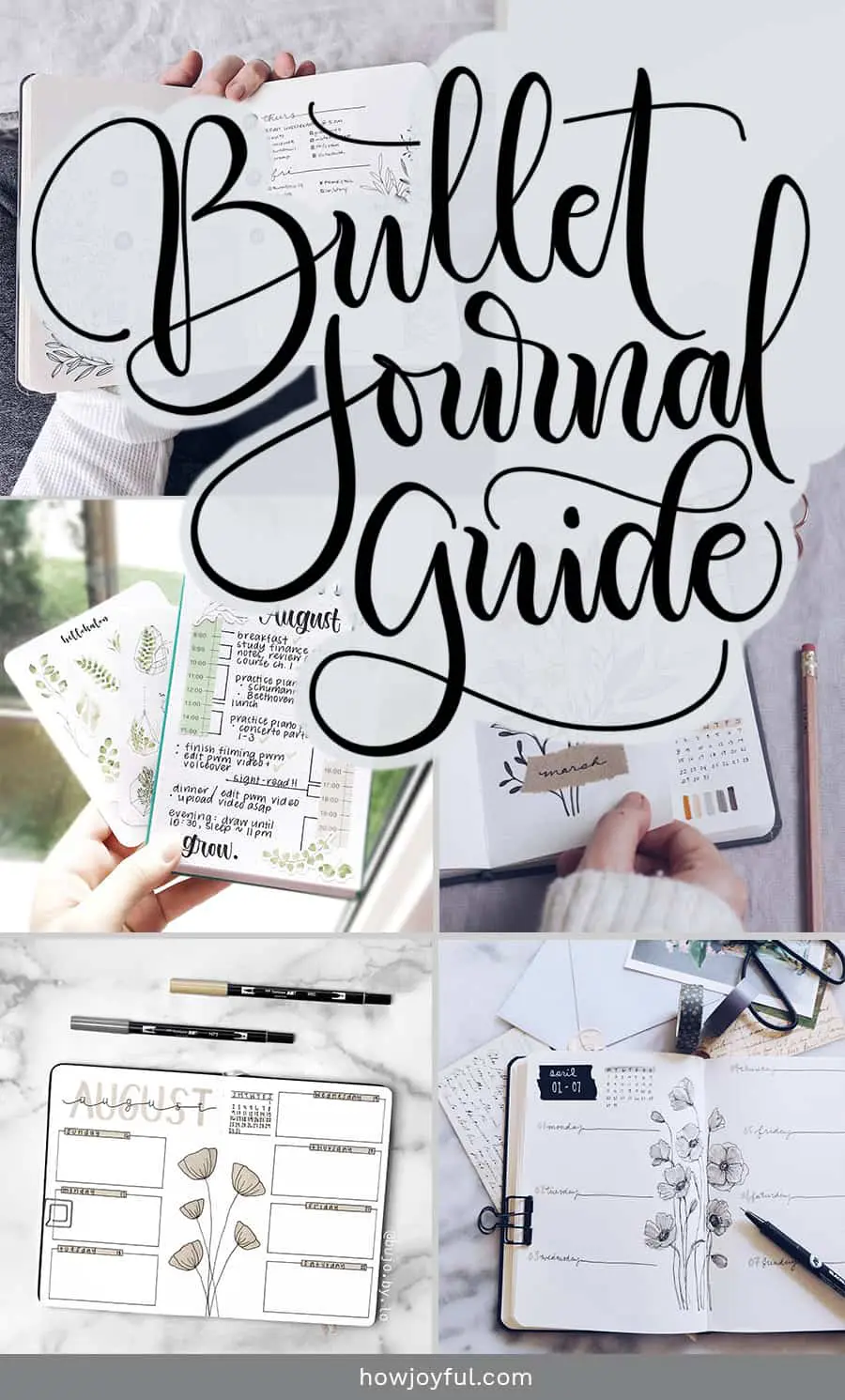
I had wanted to dip my toes into the very inviting waters surrounding Bullet Journals for a long time now. I know in the art community there seems to be a polarizing take on this productivity method. And there are as many takes as people that try it.
What I love most about the lovely art of bullet journaling is that no two journals will ever be exactly the same; even if the templates or system you use are identical, the contents will always be unique.
When you first heard the words “Bullet Journal,” what came to mind?
If you are pragmatic, pedantic, and organized: You might think it means items or “points” listed in a notebook that is preceded by a common typographical symbol, erroneously called a bullet (but actually got its name from looking like a bullet hole).
If you are romantic, creative, and descriptive: You might think it means sitting in a garden with a feathered pen writing down your hopes and dreams.
However, if you’re an ordinary person who thinks there must be a better way to list the dozens of things you need to remember than putting them in a smart device, you’ll see bullet journals as a clever and convenient choice.
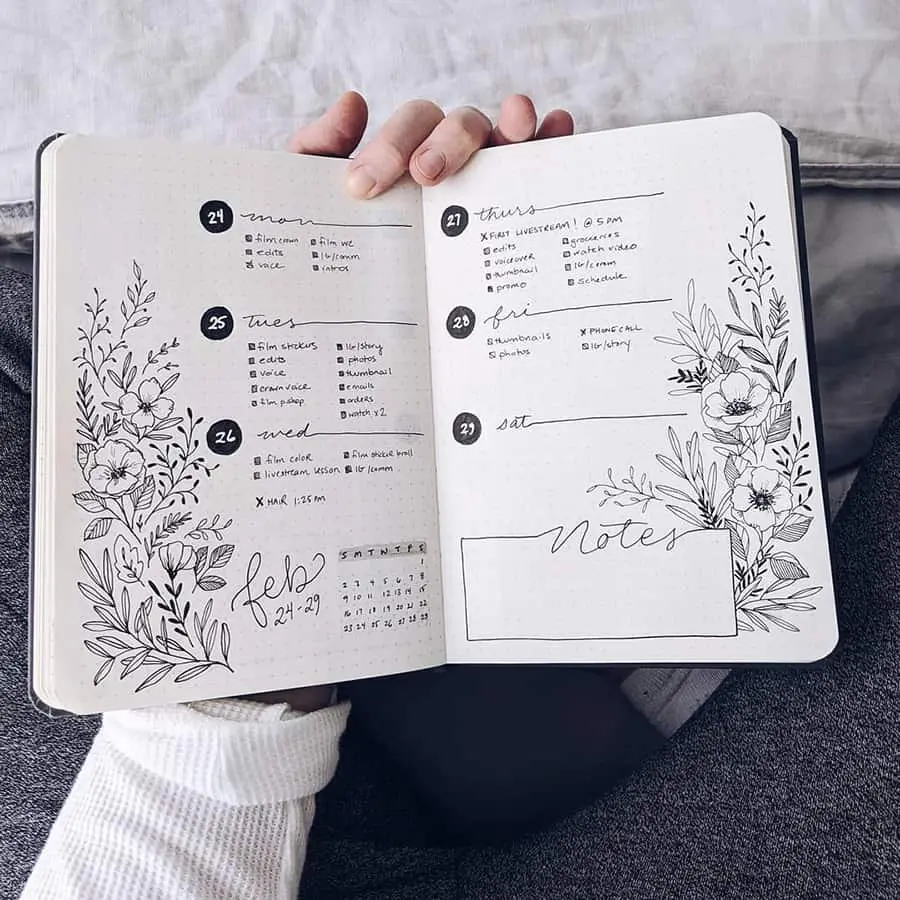
Bullet journaling is at the top of the social media wave right now and it's easy to understand why, from super simple and modern layouts to ornamented botanical-inspired spreads, chances are, you've come across one of these posts while scrolling your feed.
So today, I want to share with you a little bit of the research I did on how to make the most of them and some tips to get you started in the best way if you are looking at Bullet Journaling to increase productivity, practice mindfulness or just to organize your day-to-day life.
Below you can see everything that I will be covering in this post:
- What is a Bullet Journal and Why Should I Have One?
- Bullet Journaling: How it Came About
- Bullet Journal and Productivity
- Bullet Journal and Mindfulness
- Medieval Bullet Journaling?
- How to Approach Bullet Journaling for Beginners
- How to Use a Bullet Journal for Productivity
- Recommended Bullet Journal Supplies
- Bullet Journal Spreads
- Additional ideas for Bullet Journal (themes & doodles)
- And Now for the Science Bit About Bujos

What is a Bullet Journal and Why Should I Have One?
We’ve always needed bullet journals. In Tudor times, they were called almanacs. In the 17th century England, Samuel Pepys was a famously fanatical diary keeper who even kept a diet journal.
In the 1980s, you couldn’t throw a stick in Wall Street without it hitting someone’s Filofax.
There was even a Hollywood movie made called “The Filofax” (1990), although “Taking Care of Business” was the film’s name here in the United States.
Everyone was quite happy to consign their Filofaxes and diaries to the attic when smart devices came around in this millennia. And yet, if you are like me, there would have been a secret part of you that longed to feel the heft and weight of a tightly packed diary in your hands again.
I can remember how I loved to tote my secret notebook around at school and sit on my bed in the evenings filling in the empty pages ( I secretly home my mom still has some of them in Chile). After a while I moved out of “diaries” and started keeping track of everything in my “Agenda”, I had one for every year until college.
There is something very special about old school notebooks. They contained everything relevant and important for a teenager. Homework, project assignment due dates, phone numbers, facts and tips, magazine article cut-outs or ripped straight out of the pages. It would smell of ink and old paper with a smear of whatever lunches you liked.
In a nutshell, Bullet Journals are the adult version of homework reminder books.
Added to the mix for good measure is a hearty dose of organizational expertise and lifestyle, wellness, mindset-checking info. This updated diary/day planner/memoirs concept comes from the mind of Ryder Carroll.

Bullet Journaling: How it Came About
Ryder Carroll contributed to the evolution of journaling with the launch of his personal organizer concept in 2013 with his website and later Kickstarted for an upgraded version of the site, an accompanying Notebook, Book and App.
The book
The Bullet Journal Method
This book is about what Carroll calls “intentional living”: weeding out distractions and focusing your time and energy in pursuit of what's truly meaningful, in both your work and your personal life by working on fewer things.
Those people who thought Ryder was just trying to re-invent the wheel were wrong. The reception this organizational method received was very enthusiastic and continues to grow to this day.
A basic breakdown of Ryder’s system looks something like this:
(bullet points!↓)
- Index page
- Rapid logging system of individual symbols
- Keeping a log (to-do lists linked to days, weeks, months, and the future)
- Collections (such as fitness/diet trackers; habits/moods trackers; list of books you’d like to read/recipes to try)
- Migration
Part-day planner, part creative outlet, fans of Bullet Journaling have become more than an online community – it’s recognized as an intelligent way of living and fulfilling your life.
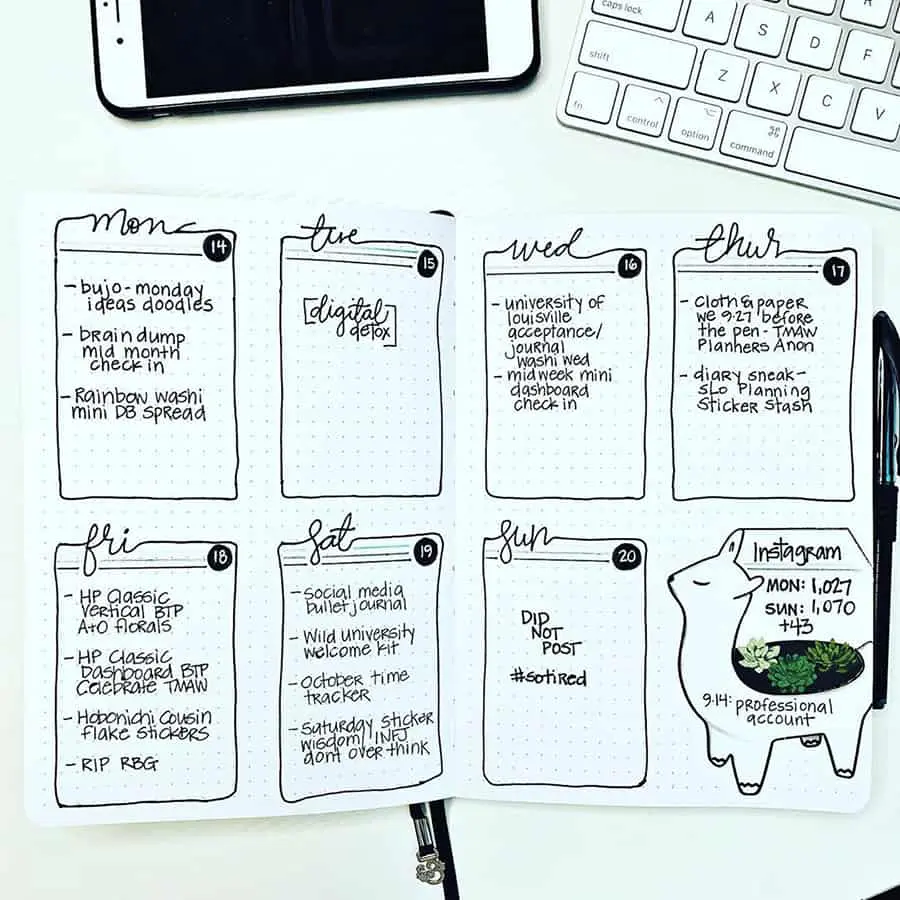
Bullet Journal and Productivity
Would you like to know more about how a bullet journal can help different aspects of your life? Here are a few public sectors that have been transformed since embracing this innovative way of keeping track of things.

1.- School
Keeping a daily bullet journal helps students succeed in all levels of schooling. There’s an entire sub-sector of school-going bullet journal fans on social media, forums, and video sharing platforms.
The tips and tricks shared in this way focus on how to stay productive and get organized. Nurturing a bullet journal habit in small children would be a brilliant way to spend time together.
Give very small kids a range of stickers, and ask them to choose one that best represents their day to glue into their journal. The interaction they have with their bullet journal can expand as they grow.
What I find the most appealing about the bullet journal + school idea is that it keeps the spirit of a diary and homework book alive while staying true to the original bujo concept.
Yes, “Bujo” is the name given to bullet journaling by the online community.

2.- Workplace
Bullet journaling and the workplace had a positively symbiotic connection from the get-go.
I have seen my friends replace their whiteboards and stand-up desk calendars with bullet journals, and be all the happier and productive for it. A bujo is more than a way to organize your workplace and career, however.
The system promotes a deeper level of interaction and integration with your lifestyle and mental health. Journaling can help you keep track of tasks, accountable for your time and focus on what's important throughout the day.
In my case, Journaling has become especially important since I do work from home.
Staying accountable for my time, helps me be more productive and intentional with my to-do list. Even though I don't go crazy scheduling every second of my day. This analog way of keeping me organized, mixed with apps like Notion and GSuite, are the perfect mix for me as a small business owner and mom of 3 little ones.

3.- Health
Mental health and physical health can be successfully managed using a bullet journal.
This is because of tracking features. Tracking is a systematic way of collecting handwritten data about your health goals.
As I mentioned previously, your bullet journal can include collections on just about anything important to you: Gratitude logs, goals, bad/good habits, moods, triggers.
This recorded information is available as an emotional outlet, a kind of “checks and balances for the mind.” One of my friends told me how her mother would spend five to ten minutes at the tiny antique writing desk in her room every morning. This was what she called her “Me” time.
She would spend those few minutes writing down things to do that day and what she called “thanking her lucky stars.”
Thanking her lucky stars was how this mother counted her blessings and got into a positive mindset for the day. I think it was an early form of bullet journaling and such a lovely thing to do.

Bullet Journal and Mindfulness
Here is a quote from a fashion industry professional:
“One of the most difficult first steps to take in the fashion industry is to put all your ideas and inspiration into tangible form. However, it’s one of the most – if not the most – important step to take.”
What is being spoken about here? Mood and vision boards.

They go on and list the reasons why mood and vision boards are essential:
- Helps you to solidify your ideas
- Makes your vision easily definable with one glance
- It helps to ensure you work towards what is on the board without straying from the path.
Does that sound like bullet journaling? It does to me. I imagine my bujo as a tiny, transportable mood board, and I’m not alone in this. Just as a designer must be so relieved to be able to look at their mood board and know they stayed true to their vision, it must be great to do the same with a bujo.
At the beginning of this page, I refer to the fine art of bullet journaling. Looking at a blank journal, it’s hard to see it as such. But remember that fine art requires expertise, and no one is more expert at planning your day, week, month, or year than you are.
The mindfulness involved when you keep a bullet journal brings about a sense of creation. Of course, there is also the more practical aspects of writing things down so you don’t forget them! Bullet journals are a mood board for the mind.
Turn your bijou bujo into a mood and vision board that will never go out of fashion!
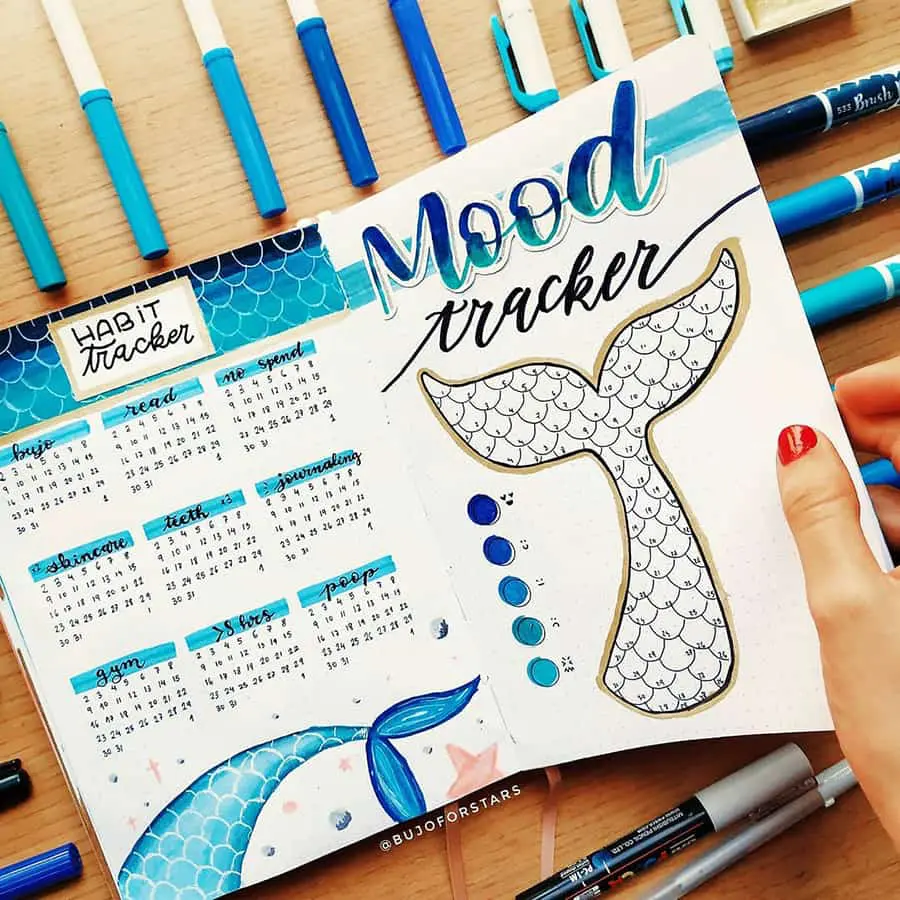
Medieval Bullet Journaling?
I found this really interesting webpage on doodling and margin drawings in medieval times. It even has a name: Manuscript marginalia.
If you plan on doing more inside the pages of your bullet journal than simply writing down tasks, you have to take a little inspiration from the creativity shown by the scribes who made these old books. The medieval manuscript writers even had a secret code – call it an early form of indexing or rapid logging if you like.
The Latin word for owl is “bubo” which also happened to be the word for a medical condition. So, the scribes would just draw an image of an owl in the margin so the doctor would know that section dealt with that disease.

How to Approach Bullet Journaling for Beginners
There are so many places where you can learn how to start writing a bullet journal. So, in true bujo tradition, I’m going to condense all the information down into bite-size pieces for you.
If you are new to the whole bullet journal thing, it’s actually a good idea to bookmark this page for future reference.
- Bullet journaling was created to take the place of chalkboards, corkboards, post-its, and any other kind of ineffectual way of remembering and keeping track of things past, present, and future.
- It’s an analog (non-digital) system. Any book with blank pages will do.
- Spread = 2 x pages
- The first 2 x blank pages (spread) in your journal is the Index.
- When you have written Index on the first blank spread, turn to the next spread: Write Future Log at the top of the pages on this spread.
- The simplest Future Log setup is a 6 month one. You divide the spread into 6 even sections and label each section with the next six months: Jan, Feb, Mar, etc.
- Add page numbers to your Future Log, for example, Page 1 and Page 2 (1 -2 for six months, 1 – 4 for a year).
- Go back to your Index pages and write: “Future Log on Pages 1 – 2”
- Turn to the next blank spread. This is to be your monthly log.
- Write the name of the month on both pages; divide the spread into days and dates of the month on the left page, as this is to act as your calendar. On the right page, write down things that need doing for that month, like so:
- Pay utilities
- Book dog grooming session
- Email Pop-pop
- Add page numbers at the bottom of the month spread. Return to index and record the pages for future reference, same as you did for the Future Log.
- Next up, set up your daily log pages. Begin by writing the day’s date at the top of the page. Add entries, also called daily logs, like so:
- Bake cookies for Food Friday at work
- Cut bangs into hair
- Call Eve to say Happy B-day
- *Remember to close out China accounts before Chinese New Year
- Fun fact…the unicorn is the national animal in Scotland!!!
- Personalize and expand your journal according to your needs and what you want to keep track of, focus on, or stay accountable for. The sky is the limit!
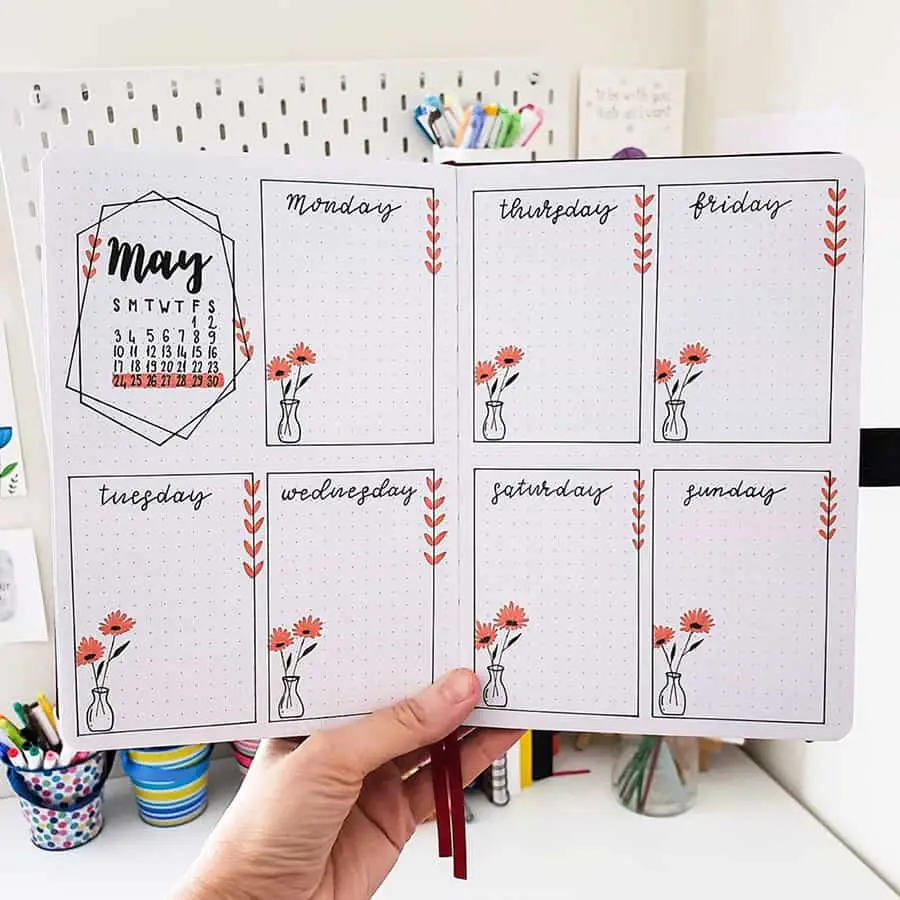
Bullet Points Key:
• = tasks
ο = events
– = notes
* = important/prioritized (it’s best to place the star * which is also called a ‘signifier’ in the margin on the left).
This typographical bulleting system is called “Rapid Logging.”
It was formulated to see information easily at a glance.
When a task is done, strike an “X” through the bullet point in the margin.
Now, these Keys are some of the most used, as you can see below, each person can make their own key sheet and add as many sections or marks as you would like.

What to Do at the End of Each Month:
Set up the monthly log for the next month the same as for the previous month. Scan through the current month spread and rapid logs for any open tasks (easy to see as the ones that haven’t been X-ed).
Now it’s time to look at the tasks that haven’t been X-ed. Ask yourself, “Is this task still worth doing?” For example, your logs might now look like this:
(1)
You can see that the “Cut bangs into hair” task hasn’t been X-ed yet. Take some time to think about whether this task is still worth doing. If it isn’t, strike a line through the whole bullet point and task, like this:
If the task is something worth doing in the future, turn the bullet point into an arrow > (the bullet point is hiding there under the arrow).
(2)
If the task is something worth doing in the future, turn the bullet point into an arrow > (the bullet point is hiding there under the arrow).
(3)
After doing this, turn to the spread for the new month, and copy the task in again.
If the task is something you only need to do months from now, turn the forward arrow marker into a backward one < for example:
November Monthly Spread with Chinese New Year only happening in January, next year would look like this:
(4)
When you have turned the bullet point for the task into a backward arrow, turn to your Future Log page spread and copy it into the month when it needs to be done. When you do this, the bullet journaling term is called “Migration.”
Why You Need Migration
Migration is important as it helps you weed out distracting or unnecessary tasks. You can see at a glance which tasks are essential, and which ones aren’t.
Ryder says it in a very clever way: It’s the difference between you being busy and being productive.
Collections
Collections are for when you need to collate related tasks and notes. The section where you organize related items is called “Collections.” Turn to your next blank spread and write down your Collection Topic at the top of the page.
Don’t forget to routinely number the pages and record them in your Index section at the beginning of your journal. Next, migrate all the tasks and notes related to the collection into the new pages.
Like this:
Recipes I Must Try Soon (Topic)
- Make own hummus
- Those 3 ingredient pb cookies w/ 1 cup organic pure pb; 1 cup sugar; 1 egg
- Lamb tagine
Catch Up on Marvel-verse movies (Topic)
- Antman 2
- Infinity War
- End Game
Dream Diary (Topic)
- Oxblood red house with very green flowers
- My ex kept on asking me to buy flowers
- Cat lying on a crochet blanket
After getting all your pages indexed, you can go back and check that the pages match the numbers. So your index will now look like this:
- Recipes I must try soon: Page 34
- Marvel-verse movies to catch up: Page 35
- Dream Diary: Page 36
Trackers
If you hear someone referring to “my trackers” in bujo world, it means the Monthly, Weekly, and Daily pages of a bullet journal.
In the speech, this will sound like this: “I have come up with a new Celtic knot symbol design to decorate my May monthly margins.” “I plan on changing my weekly spread format from boxes to columns.” “I have made a resolution to track my snack attacks in my dailies.”
And that’s it!
You are now a fully-fledged bullet journalist ready to start writing your first index. If all this page numbering and line drawing seem too much like a task on one of your own lists, don’t worry.
There are beautiful bullet journaling books available that will take all the hard work out of starting your bujo.

How to Use a Bullet Journal for Productivity
Like Ryder Carrol himself says: productive, not busy.
So, here are a few tips on how to use a bullet journal for productivity.
- You will never see someone who keeps a bullet journal aimlessly wandering around the supermarket. They will have their journal out in front of them and be ticking off the produce they need as it goes into the shopping trolley. Saves money and saves time. Plus, there’s no chance of them sneaking in junk food either, because they will have “DON’T BUY JUNK FOOD” written in there as well.
- Say goodbye to App Zombieland. Bullet journals are far more interesting to play with. Instead of having your face down, and your attention buried in a game guaranteed to set you up to fail, you can jot down thoughts and sights – taking time to look up and around to see the world.
- You never forget or postpone anything. It is always there to remind you.
Recommended Bullet Journal Supplies
Here is the list of my favorite materials to start with bullet journaling. In order to get started though, all you need is a notepad and a pen.
But it doesn't hurt to step up the game and get some of these cool supplies:
This was the first notebook I purchased when I started doing bullet journaling. I love that it is the official Notebook recommended by Ryder Carroll. But my favorite feature is the thickness of the page. Almost no marker will bleed to the other side. Another option is the regular Leuchtturm 1917, I always recommend to look for the dotted version, this is what I used for lettering because of the dotted grid, they are the best! I love this liner pen set because they come in all the different thicknesses you need to start journaling. A great bang for your buck! Tombow's are most Artist favorite pens, and this set offers the best of both worlds, you get a pencil, eraser and some brush markers, I like that if you just go with this one, you will not need to get separate pencil and eraser. Just as important as the inking part, you will need pencils and erases to start your spreads, this election by Amazon offers a great variety for the price. Same as the circle maker, this ruler is a must for anyone making straight lines. It has a roll in one end, so you can just glide the ruler to get it up or down the line you already created. Whenever you are creating circular graphics, like mood trackers, this little thing will be your best friend! It has helped me create them so fast! If you want to add more color to your planner, these fine lines are a perfect alternative, because you are keeping the thin point, just adding a wide variety of colors. Gel pens are almost essential when bullet journaling so you can add details but also so that you can build up details in layers. I love using the white on top of my regular brush pens for details and depth. These are some of my favorites brush pens, and I love that they also come in bright colors, just make sure you select the brush tip because Pentel has a pack that looks exactly the same, but with a regular tip. These are a great budget-friendly option to not only add color but also add brush calligraphy details to your bullet journal. Since you are able to get different thickness depending on o pressure and angle. I also wanted to add this option by Amazon because it's a little more budget-friendly.
Bullet Journal Notebook

Leuchtturm1917 Dotted Hardcover

Sakura Drawing Kit -

Tombow Lettering Set

Pencil Kit - 17-Piece Set

Parallel Rolling Ruler

Circle Maker with Templates
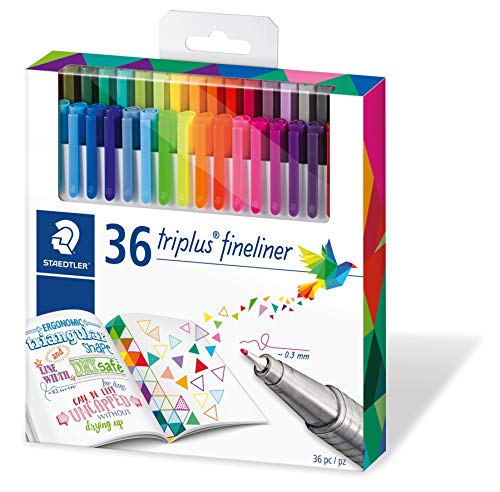
Staedtler Triplus Fineliner Pens

Gel Pens Set

Pentel Fude Brush Set

Crayola Super Tips

Notebook with Pen Loop
Bullet Journal Spreads
Here are some of the more inspiring ideas for the best bujo spread layouts. You can do something similar in yours, or try something completely different. Don’t worry if you’re a bujo beginner, you will soon spread your wings and be able to create your own original spread!
I wanted to share some inspiration for different kinds of spreads since the most common ones are:
- 1 – Cover Pages
- 2 – Monthly spreads
- 3 – Weekly spreads
- 4 – Daily spreads
- 5 – Year or semester overview
- 6 – Goal tracker spreads
- 7 – Mood tracker spreads
Here are some of my favorites from artists on IG (Check on the credits to follow each one of them!)
1– Cover pages: As the name gives away, these are pages that are used to separate months or a different section of your planner. They are mostly only doodles and a tittle but feel free to go as fancy or simple as you would like.



2– Monthly spreads: Spreads are either one of two pages that show a specific time you want to be accountable for. What I like the most about the monthly spreads is that you have an easy overview of the whole month, so it makes sit very easy to plan ahead.


3– Weekly spreads: Weekley spreads show a particular week in full, just like with the monthly spread, you can use either one or two pages, but it's easy when you use two pages for them to be facing each other.
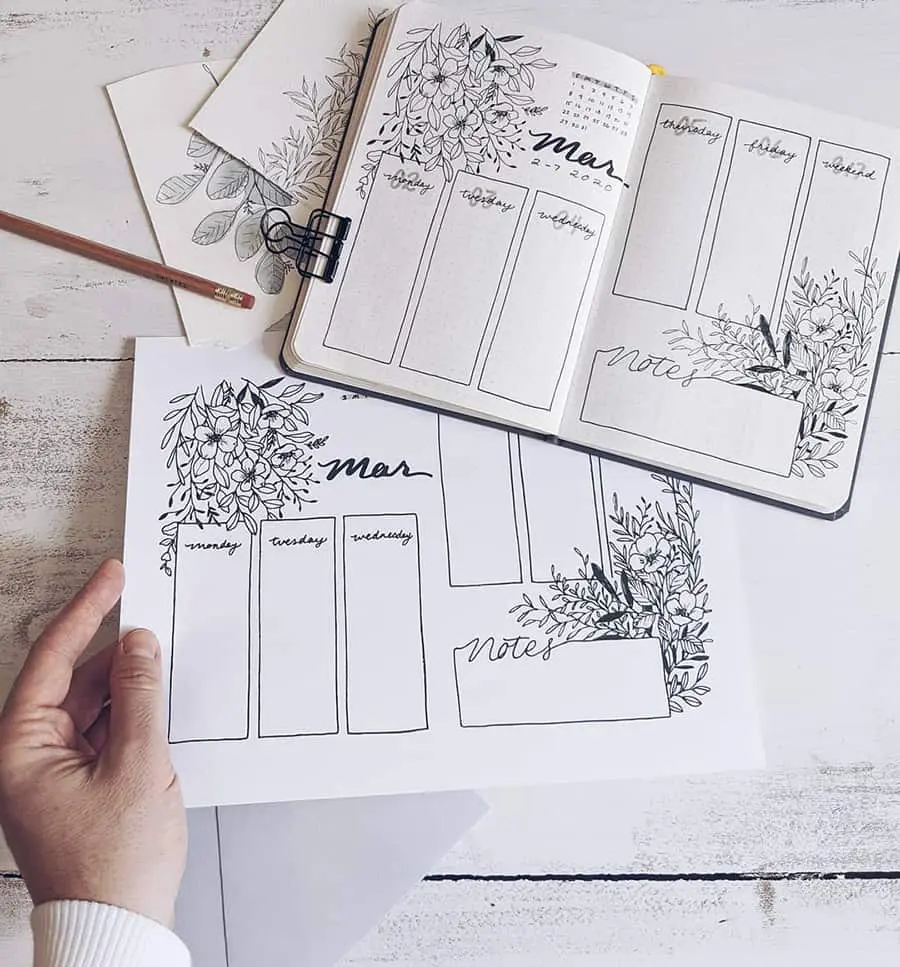


4– Daily spreads: Daily spreads show full days with the blocks of time you wish to track, I love how simple these can be and all the different things you can keep track of on top of your time (ex. Water intake, workout time, foods and times of consumption, etc)


5– Year or semester overview: As the name implies these spreads contain either the full year or a semester, really anything more than just the regular one month, they are used as calendar overviews or as different tracking systems, there's something so magical about seeing the full year into tiny little squares (or whatever shape you prefer)


6– Goal tracker spreads: I love goal trackers, especially when you design them in a way where you have an action plan in order to achieve your goal. It makes is so much more straight forward than just wishing for stuff.


7– Mood tracker spreads: Mental health is a very important thing to be aware of when you are trying to stay productive. So I like to keep track of my mood to make sure I am not overworking myself and I am leaving time to enjoy with my little ones.


Additional ideas for Bullet Journal (themes & doodles)
I have looked through a number of bujo systems when compiling these definitive bullet journal guidelines and found a bullet point key that I really love. I want to share them with you for when you have the basics down and want to refine your system even further.
1– HEADER IDEAS


2– THEME IDEAS



3– ADDING BOTANICALS



4– ADDING DOODLES

And Now for the Science Bit About Bujos
There is a scientific link between handwriting your notes and your memory. Psychologists and neuroscientists have found that only writing something by hand is effective for remembering what you are making a note. By going old school instead of digital, you not only retain the information – you comprehend new ideas and become more productive.
Additionally, by writing in your bujo, you’re eliminating the possibility of being distracted by your device. Doing something I enjoy and benefiting from instant later recall and better long-term memory? Where do I sign up!?
That’s all the information you need to get your bujoing off to a flying start. I have tried to K.I.S.S. (keep it straight and simple) this definitive bujo guide. I think it’s easier to understand and get started that way.

References
- Bullet Journal – Wikipedia
- Mood board vs Vission board – Source my Garment
Manuscript Marginalia
- Medieval Subversive art – CNN
- Medieval Marginalia books – AltasObscura
- What is Bullet Journaling? – Good Housekeeping
Writing & memory
If you are looking for more ideas for your bullet Journals, stay tuned as I will not only cover inspiration but also tutorials to help you draw beautiful flowers and doodles for your spreads.
I hope you enjoyed this post.
Until next time, keep creating!


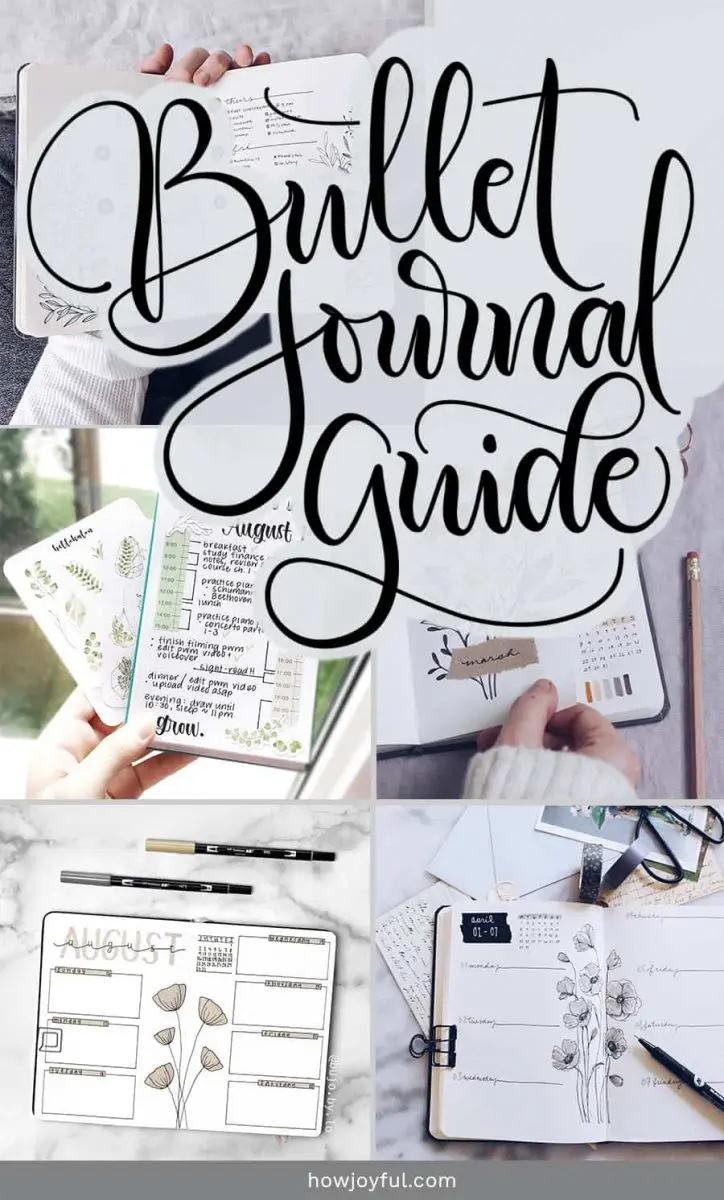


Jenna
Sunday 29th of December 2019
I just ordered the book, I am excited to get started. Thank you
Joy Kelley
Wednesday 1st of January 2020
Yay! It's such a good book, you will not regret it! =]
Maria
Sunday 15th of December 2019
Thank you for sharing so much about bullet journaling, I've been curious about is and it sounds pretty doable (not the pages full of art, but the minimal ones)
Joy Kelley
Wednesday 1st of January 2020
I am so happy you want to give it a try! And yes the minimal pages are definitely the best way to get started, you never know, maybe you'll be doing pages full of art pretty soon =]
Emily
Thursday 12th of December 2019
Very cute! I am so excited to start with bullet journaling
Joy Kelley
Wednesday 1st of January 2020
So happy you want to give it a try!
Joy
Tuesday 16th of April 2013
Hi Eugenia!
I'm sorry but I found this on my local thrift shop, so it was just an old used item someone donated and I restore it, maybe www.Etsy.com can be a good place to search? I wish you a lovely day and good luck on trying to find one!
=]